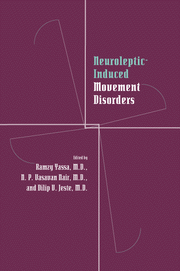Book contents
- Frontmatter
- Contents
- Contributors
- Preface
- Part I Historical perspective
- Part II Clinical aspects of tardive dyskinesia
- Part III Mechanisms underlying tardive dyskinesia
- 11 Neurochemistry of the basal ganglia
- 12 A reanalysis of the dopamine theory of tardive dyskinesia: the hypothesis of dopamine D1/D2 imbalance
- 13 Tardive dyskinesia and phenylalanine metabolism: risk-factor studies
- 14 Neuroendocrinological studies of tardive dyskinesia
- 15 Cognitive deficits and tardive dyskinesia
- 16 Studies of tardive dyskinesia using computed tomography and magnetic-resonance imaging
- 17 Rodent and other animal models of tardive dyskinesia during long-term neuroleptic-drug administration: controversies and implications for the clinical syndrome
- Part IV Measurement of tardive dyskinesia
- Part V Tardive dyskinesia in different populations
- Part VI Other neuroleptic-induced movement disorders
- Part VII Treatment of tardive dyskinesia
- Index
11 - Neurochemistry of the basal ganglia
from Part III - Mechanisms underlying tardive dyskinesia
Published online by Cambridge University Press: 09 October 2009
- Frontmatter
- Contents
- Contributors
- Preface
- Part I Historical perspective
- Part II Clinical aspects of tardive dyskinesia
- Part III Mechanisms underlying tardive dyskinesia
- 11 Neurochemistry of the basal ganglia
- 12 A reanalysis of the dopamine theory of tardive dyskinesia: the hypothesis of dopamine D1/D2 imbalance
- 13 Tardive dyskinesia and phenylalanine metabolism: risk-factor studies
- 14 Neuroendocrinological studies of tardive dyskinesia
- 15 Cognitive deficits and tardive dyskinesia
- 16 Studies of tardive dyskinesia using computed tomography and magnetic-resonance imaging
- 17 Rodent and other animal models of tardive dyskinesia during long-term neuroleptic-drug administration: controversies and implications for the clinical syndrome
- Part IV Measurement of tardive dyskinesia
- Part V Tardive dyskinesia in different populations
- Part VI Other neuroleptic-induced movement disorders
- Part VII Treatment of tardive dyskinesia
- Index
Summary
Until recently, it was believed that the basal ganglia had a small role in behavior limited to the control of motor behavior. Research during the past decade, however, suggests that the basal ganglia are involved in a wide range of behaviors, including not only skeletomotor and oculomotor activities but also limbic, affective, and cognitive functions. These changes in our understanding of the organization and function of the basal ganglia have followed important advances deriving from anatomic, pharmacologic, and physiologic studies.
Structures of the Basal Ganglia
The basal ganglia include the caudate, putamen, and ventral striatum, as well as the globus pallidus, subthalamic nucleus, and substantia nigra. Together, the caudate, putamen, and ventral striatum form the neostriatum; they also constitute the input stage of the basal ganglia. The globus pallidus, which is divided into internal (GPi) and external (GPe) segments, lies medial to the putamen. The substantia nigra has two components: the pars compacta (SNc) and the pars reticulata (SNr). The SNr and the GPi are cytologically similar and often are considered as a single structure. Both the SNr and GPi are recognized as major sources of the basal-ganglia output (Nauta, 1979).
Input to the Basal Ganglia
The neostriatum is the largest and most important receptive region of the basal ganglia. Inputs to the neostriatum originate mainly in the cortex, thalamus, and SNc, with less prominent inputs arising in the globus pallidus, subthalamic nucleus (STN), dorsal raphe, and pedunculopontine tegmental nucleus.
- Type
- Chapter
- Information
- Neuroleptic-induced Movement DisordersA Comprehensive Survey, pp. 129 - 140Publisher: Cambridge University PressPrint publication year: 1996

